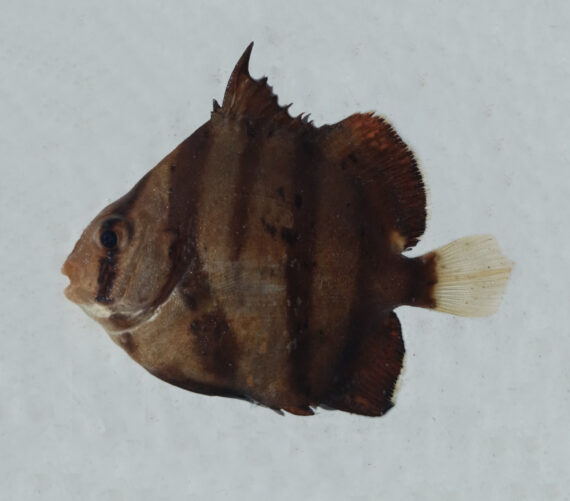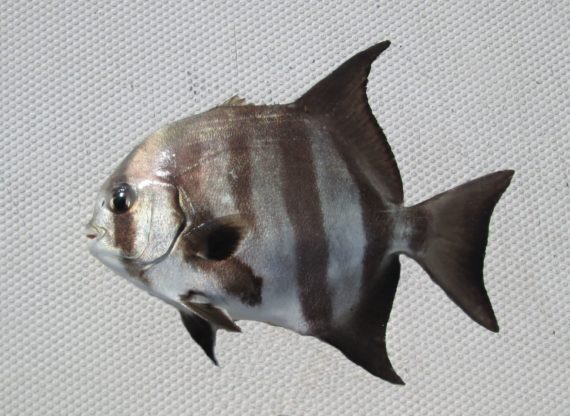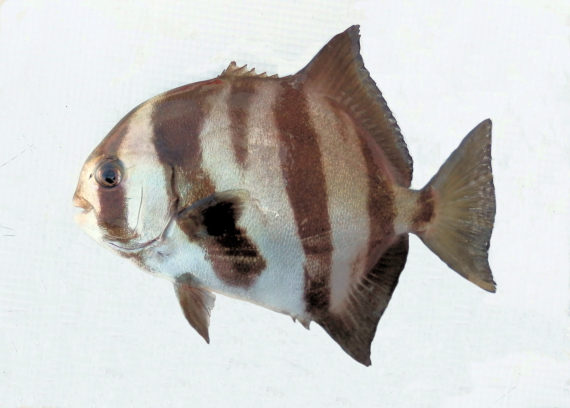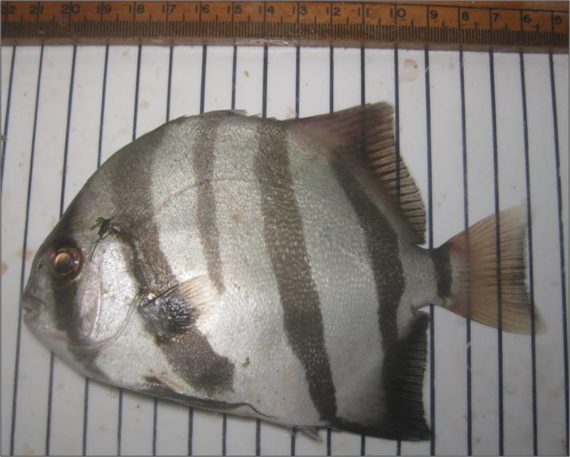Pacific Spadefish, Chaetodipterus zonatus
 Pacific Spadefish, Chaetodipterus zonatus, Juvenile. Fish caught from within the coastal waterway off Puerto Adolfo Lopez Mateos, Baja California Sur, September 2021. Catch and photograph courtesy of Jimmy Camacho, Lopez Mateos.
Pacific Spadefish, Chaetodipterus zonatus, Juvenile. Fish caught from within the coastal waterway off Puerto Adolfo Lopez Mateos, Baja California Sur, September 2021. Catch and photograph courtesy of Jimmy Camacho, Lopez Mateos.
 Pacific Spadefish, Chaetodipterus zonatus. Fish caught from coastal waters off Mazatlán, Sinaloa, October 2014. Length: 28 cm (11 inches). Catch and photograph courtesy of George Brinkman, Guelph, Ontario, Canada.
Pacific Spadefish, Chaetodipterus zonatus. Fish caught from coastal waters off Mazatlán, Sinaloa, October 2014. Length: 28 cm (11 inches). Catch and photograph courtesy of George Brinkman, Guelph, Ontario, Canada.
 Pacific Spadefish, Chaetodipterus zonatus. Fish caught from coastal waters with Magdalena Bay, Baja California Sur, March 2017. Length: 30 cm (12 inches).
Pacific Spadefish, Chaetodipterus zonatus. Fish caught from coastal waters with Magdalena Bay, Baja California Sur, March 2017. Length: 30 cm (12 inches).
 Pacific Spadefish, Chaetodipterus zonatus. Fish provided by the commercial fishermen of Bahía Kino, Sonora, November 2014. Length: 39 cm (15 inches). Photograph courtesy of Maria Johnson, Prescott College, Kino Bay Center, Kino Bay, Sonora.
Pacific Spadefish, Chaetodipterus zonatus. Fish provided by the commercial fishermen of Bahía Kino, Sonora, November 2014. Length: 39 cm (15 inches). Photograph courtesy of Maria Johnson, Prescott College, Kino Bay Center, Kino Bay, Sonora.
 Pacific Spadefish, Chaetodipterus zonatus. Fish caught from coastal waters off Mazatlán, Sinaloa, March 2016. Length: 39 cm (15 inches). Catch, photograph, and identification courtesy of Josh Leisen (joshadventures.com), Gaylord, Michigan.
Pacific Spadefish, Chaetodipterus zonatus. Fish caught from coastal waters off Mazatlán, Sinaloa, March 2016. Length: 39 cm (15 inches). Catch, photograph, and identification courtesy of Josh Leisen (joshadventures.com), Gaylord, Michigan.
The Pacific Spadefish, Chaetodipterus zonatus, is a member of the Spadefish or Ephippidae Family, that is known in Mexico as chambo. Globally, there are three species in the Chaetodipterus Genus, of which two are found in Mexican waters, one in the Atlantic and one, this species, in the Pacific Ocean.
The Pacific Spadefish has a highly compressed deep oval body with a depth that is 61% to 65% of standard length. They are silvery white to grayish with 6 wide vertical black bars on their body. Their anal and pelvic fins are dusky black and their caudal and pectoral fins are yellowish. Their rounded head has a very short blunt snout and a small mouth that opens at the front with small brush-like teeth in bands. Their anal fin has 3 spines and 16 to 20 rays; their caudal fin is slightly concave; their first dorsal fin has 9 spines, the third being the longest, with the spines being low, well-developed and connected by a membrane; their second dorsal fin has 18 to 23 rays; their pectoral fins are short; and, their pelvic fins are under the pectoral fins. Their anal and dorsal fins are similarly shaped and located well back on the body. Their lateral line forms a gradual and continuous arch and is highly visible. Their body is covered with scales.
The Pacific Spadefish inhabits bays and inlets with sand or rubble bottoms and are found at depths up to 105 m (350 feet). They reach a maximum of 66 cm (2 feet 2 inches) in length. They feed on algae and a variety of benthic and planktonic invertebrates including gorgonian corals, polychaete worms, sponges, tunicates, and zoantharians. The Pacific Spadefish is poorly studied with very limited information available about their lifestyle and behavioral patterns including specific details on age, growth, longevity, movement patterns, diet, habitat use, and reproduction.
The Pacific Spadefish is a resident of all waters of the Pacific Ocean.
The Pacific Spadefish cannot be confused with any other species ue to its body depth and barring pattern.
From a conservation perspective the Pacific Spadefish is currently considered to be of Least Concern with stable, widely distributed populations. They caught as a by-catch of by commercial gill-net fishermen and open sandy bottom trawlers but are only retained by subsistence fishermen. They are classic nibblers and very difficult to catch via hook and line.